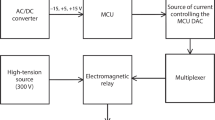Summary
The purpose of this study is to develop a reliable method for obtaining information about “spontaneous respiration” in paralysed cats. Therefore action potentials from one of the phrenic nerves are recorded. In a spontaneously breathing animal, a CO2 rebreathing experiment is performed in order to obtain a relationship between phrenic nerve activity and tidal volume. This phrenic nerve activity is corrected for the noise measured during expiration and quantified proportional to the square root of the mean impulse rate of the whole nerve bundle. Thus, high correlation coefficients (0.95 or more) between phrenic nerve activity and tidal volume can be obtained.
After paralysing the cat this relationship can be used to estimate “spontaneous tidal volume” from the phrenic nerve activity. It appears to be necessary to perform unilateral phrenicotomy on the nerve from which recordings are taken, because there is a considerable amount of afferent signals in the phrenic nerve which is dependent on the stroke volume of the respirator, on the alveolarP CO2and somewhat on the alveolarP O2.
It is concluded that after vagotomy and phrenicotomy and if suitably quantified, the electrical activity in the phrenic nerve gives accurate information on “spontaneous ventilation” in a paralysed cat.
Similar content being viewed by others
References
Cherniack, N. S., Stanley, N. N., Tuteur, P. G., Altose, M. D., Fishman, A. P.: Effects of lung volume changes on respiratory drive during hypoxia and hypercapnia. J. appl. Physiol.35, 635–641 (1973)
Clark, F. J., von Euler, C.: On the regulation of depth and rate of breathing. J. Physiol. (Lond.)222, 267–295 (1972)
Corda, M., von Euler, C., Lennerstrand, G.: Proprioceptive innervation of the diaphragm. J. Physiol. (Lond.)178, 161–177 (1965)
Dick, D. E., Meyer, J. R., Weil, J. V.: A new approach to quantitation of whole nerve bundle activity. J. appl. Physiol.36, 393–397 (1974)
Duron, B., Caillol, M. C.: Investigation of afferent activity in the intact phrenic nerve with bipolar electrodes. Acta neurobiol. exp33, 427–432 (1973)
Eldridge, F. L.: Relationship between phrenic nerve activity and ventilation. Amer. J. Physiol.221, 535–543 (1971)
Fitzgerald, R. S.: Relationship between tidal volume and phrenic nerve activity during hypercapnia and hypoxia. Acta neurobiol. exp.33, 419–425 (1973)
Folgering, H. Th., Bernards, J. A., Sistermans, J. F., Michels, B.: Automatic stabilisation of inspiratory oxygen pressure and endexpiratory carbon dioxide pressure in a closed spirometer system. Pflügers Arch.347, 351–357 (1974)
Gesell, R., Kearny Atkinson, A., Brown, R. C.: The gradation of the intensity of inspiratory contractions. Amer. J. Physiol.113, 659–673 (1940)
Gill, P. K.: The effects of end-tidal CO2 on the discharge of individual phrenic motoneurones. J. Physiol. (Lond.)168, 239–257 (1963)
Glebovskii, V. D.: Stretch receptors in the diaphragm. Fed. Proc.22, 405–410 (1963)
Katz, R. L., Fink, B. R., Ngai, S. H.: Relationship between electrical activity of the diaphragm and ventilation. Proc. Soc. exp. Biol. (N.Y.)110, 792–794 (1962)
Kindermann, W., Pleschka, K.: Phrenic nerve response to passive muscle stretch at different arterial CO2 tensions. Respir. Physiol.17, 227–237 (1973)
Lourenço, R. V., Cherniak, N. S., Malm, J. R., Fishman, A. P.: Nervous output from the respiratory center during obstructed breathing. J. appl. Physiol.21, 527–533 (1966)
Lourenço, R. V., Miranda, J. M.: Drive and performance of the ventilatory apparatus in chronic obstructive lung disease. New Engl. J. Med.279, 53–59 (1968)
Lourenço, R. V., Mueller, E. P.: Quantification of the electrical activity in the human diaphragm. J. appl. Physiol.22, 598–600 (1967)
Mognoni, P., Saibene, F., Sant Ambrogio, G.: Contribution of the diaphragm and the other inspiratory muscles to different levels of tidal volume and static inspiratory effort in the rabbit. J. Physiol. (Lond.)202, 517–534 (1969)
Pitts, R. F.: Exictation and inhibition of phrenic motoneurones. J. Neurophysiol.5, 75–88 (1942)
Woldring, S.: Interrelation between lung volume, arterial CO2 tension and respiratory activity. J. appl. Physiol.20, 647–652 (1965)
Yasargil, G. M.: Proprioceptive Afferenzen im N. phrenicus der Katze. Helv. physiol. pharmacol. Acta20, 39–58 (1962)
Yasargil, G. M., Koller, E. A.: Über die motorische Innervation des Zwerchfells beim Kaninchen. Helv. physiol. pharmacol. Acta22, 137–147 (1964)
Author information
Authors and Affiliations
Rights and permissions
About this article
Cite this article
Smolders, F.D.J., Folgering, H.T. & Bernards, J.A. Ventilation estimated from efferent phrenic nerve activity in the paralysed cat. Pflugers Arch. 359, 157–169 (1975). https://doi.org/10.1007/BF00581285
Received:
Issue Date:
DOI: https://doi.org/10.1007/BF00581285




